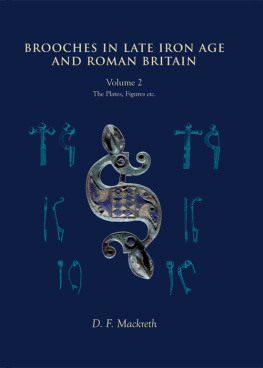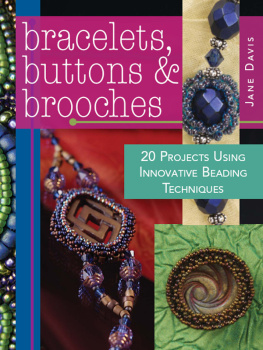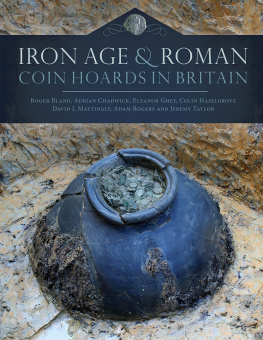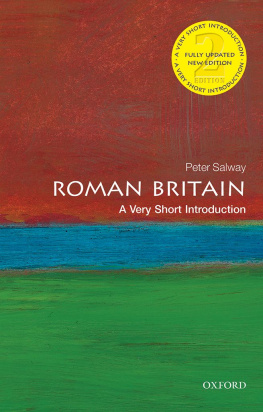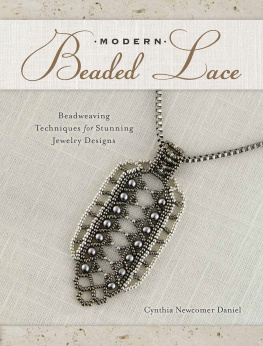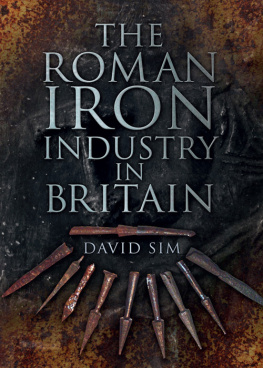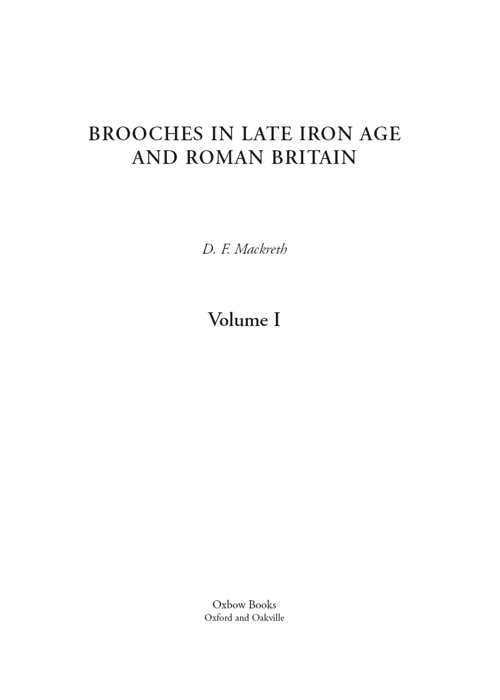
Published by
Oxbow Books, Oxford, UK
Oxbow Books and D. F Mackreth 2011
ISBN 978 1 84217 411 1
ISBN 9781842176429 (epub)
ISBN 9781842176436 (prc)
A CIP record for this book is available from the British Library
This book is available direct from
Oxbow Books, Oxford, UK
(Phone: 01865241249; Fax: 01865794449)
and
The David Brown Book Company
PO Box 511, Oakville, CT 06779, USA
(Phone: 8609459329; Fax: 8609459468)
or from our website
www.oxbowbooks.com
Library of Congress Cataloging-in-Publication Data
Mackreth, Donald.
Brooches in late Iron Age and Roman Britain / D.F. Mackreth.
v. cm.
Includes bibliographical references.
ISBN 978-1-84217-411-1
1. England, Southern--Antiquities. 2. Brooches--England, Southern--History--To 1500. 3. Material culture--England, Southern--History--To 1500. 4. Iron Age--England, Southern. 5. England, Southern--Antiquities, Roman. 6. Excavations (Archaeology)--England, Southern. I. Title.
DA90.M33 2010
936.2--dc22
2010050973
Printed and bound by
Short Run Press, Exeter
To Graham Webster who caused more trouble than he intended
Alternative views:
There once was a brooch in a barrow
Whose main part was long thin and narrow
The pin had come off
One end was a trough
And the other was shaped like a marrow.
(Miriam Mackreth aet. 11)
Prologue
Why did I choose brooches to study? I can lay the blame firmly at the feet of Graham Webster who instigated the carefully tiered courses on excavation for amateurs at Wroxeter. The Advanced Course, last held in 1963, required the student to choose a class of object to study using what was, for those times, a good archaeological library assembled for the course. The intention was, no doubt, to illustrate the general difficulty in carrying out such a study in a short time with only a general library and no actual collections. I chose brooches on the grounds that they looked vaguely interesting and were certainly prettier than, say, horseshoes or tiles. The point about inadequacy of time and resources was quickly made.
In 1963 one had what was known to everyone as Camulodunum, now Hawkes and Hull 1947, and the chapter on brooches in Collingwood's The Archaeology of Roman Britain and that was that. Sir Ian Richmond's attempt to inject some sense into Collingwood's useless alphabetical system (Collingwood and Richmond 1969, Chapter 15) was well-intentioned but a failure: Collingwood did not use the whole alphabet and the term Dolphin has bedevilled the literature ever since. Thereafter, there were various excavation reports in which small finds were treated on a scale of good to bad, the former being at the level of Richborough IV and the latter being the Great Casterton excavations 1, 2 and 3 (Corder 1951, 1954 and 1961) in which small finds as such did not figure. There was, of course, Excavations at Camerton, Somerset (Wedlake 1958) which was both good and bad: there was a discussion at least by M. R. Hull, but the objects were very poorly illustrated. There were other reports in which the brooches were merely diagrams, so badly drawn that even a basic type could hardly be distinguished. It would be invidious to name any example every student of any class of material will have come across such.
Using the library of the Thoroton Society of Nottinghamshire, my local society, I began a card index on the small, and cheap, 5 by 3 inch size. I soon became aware that M. R. Hull had been working on brooches for thirty years with a view to publishing and, being sensitive of treading on toes, I asked Sir Ian Richmond, the then doyen of Romano-British studies, whether I should continue. His advice was to carry on. As I could not know what was going to be significant, I drew every item I came across and have never regretted the arduous labour. I was asked why I did not resort to the camera; after all, I was familiar with the problems of photographing buildings, both inside and out. The reason was simple: a drawing can be given as many detailed views as are necessary and obscure detail made clear. Photographs are fine, but what is gained in initial speed is lost in subsequent study: photographs are less easy to sort than index cards. A drawing with notes was both much cheaper and more effective, and this is as true today as it was then.
After 500 items had been quickly gathered the road began to get harder. The amount of excavation carried out in the earlier 1960s was, in total area, minute compared with what was to follow in the 1970s and later. The production of excavation reports was limited and they were very small, nearly all going into county journals. Therefore, the only way forward was to visit museums and go through journal runs at a major library. I dealt with museums at Scunthorpe, Lincoln, Newark and Nottingham University, Cirencester and Devizes fairly rapidly, but there were constraints of cost and time. I only had a limited annual holiday, and sparse means. Although a member of the RAI with free access the Library of the Society of Antiquaries, I only really had the weekend to visit, which was not much use. As the 1960s progressed, I got sucked more and more into excavation and finally, I went to university. Thereafter, all was changed. The prime constraints of dealing with material still remain, but I was fortunate in being asked to report on newly excavated assemblages, and the flood of publication since 1970 has made life relatively easy. However, museum collections are still grossly under represented in my index, only that of the University Museum at Cambridge being an addition of any consequence.
By 1965 I knew that at least 2,000 brooches were needed before anything really useful could emerge from the material. I started a separate site index to record which brooches occurred on what sites. By 1975 features which had not been conceived ten years earlier in assemblages were beginning to show. The biggest groups of brooches proved to be the Colchester and its Derivatives. I decided to leave detailed classification until later and so grouped them under how the pins were mounted. Until then, artistic aspects were the chief means used to divide the material. My method was, in its way, just as arbitrary as putting all with bulbous foot-knobs, or all with enamel, together. The chief value of my method was that the technical aspect was safe: Art could wait. As it happens, by accident I had stumbled upon a great truth, but brooches had already been classified as having hinged pins or springs mounted in the Polden Hill method etc., and everyone knew, of course, what a Poor Man's Brooch was.
Once I had the 2,000 records, it was obvious that I would need at least 5,000 and then the figure became 10,000 and that is probably a fair base for study: new types are now excessively rare. More than 99% of the material coming my way can be slotted into existing categories and new sub-varieties are easier to spot and deal with. In the beginning I ignored the large Plate Brooch group and Penannulars. The first exclusion was unfortunate for those wanting reports naturally expected all brooches to be included. Penannulars I put off for much longer, Mrs Fowler's paper being so easy to use, but I had to give in as I realised that, if dating had improved for all classes of material, then it would have also done so for Penannulars. Originally I had thought I would only deal with post-conquest brooches: Iron Age brooches could be ignored. This was an easy decision, it being commonly thought that the Colchester was a mainly post-conquest type, the dearth of published Iron Age collections hiding from view what was actually happening in the 100 to 150 years before A.D. 43. The acceleration in Iron Age studies since the middle 1960s has been such that it would take a very fool-hardy person indeed to insist that a political act in one particular year immediately changed what a society, governed by custom and tradition, wore.
Next page
